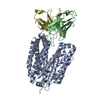+Search query
-Structure paper
| Title | Structural and molecular basis of choline uptake into the brain by FLVCR2. |
|---|---|
| Journal, issue, pages | Nature, Year 2024 |
| Publish date | May 1, 2024 |
 Authors Authors | Rosemary J Cater / Dibyanti Mukherjee / Eva Gil-Iturbe / Satchal K Erramilli / Ting Chen / Katie Koo / Nicolás Santander / Andrew Reckers / Brian Kloss / Tomasz Gawda / Brendon C Choy / Zhening Zhang / Aditya Katewa / Amara Larpthaveesarp / Eric J Huang / Scott W J Mooney / Oliver B Clarke / Sook Wah Yee / Kathleen M Giacomini / Anthony A Kossiakoff / Matthias Quick / Thomas Arnold / Filippo Mancia /    |
| PubMed Abstract | Choline is an essential nutrient that the human body needs in vast quantities for cell membrane synthesis, epigenetic modification and neurotransmission. The brain has a particularly high demand for ...Choline is an essential nutrient that the human body needs in vast quantities for cell membrane synthesis, epigenetic modification and neurotransmission. The brain has a particularly high demand for choline, but how it enters the brain remains unknown. The major facilitator superfamily transporter FLVCR1 (also known as MFSD7B or SLC49A1) was recently determined to be a choline transporter but is not highly expressed at the blood-brain barrier, whereas the related protein FLVCR2 (also known as MFSD7C or SLC49A2) is expressed in endothelial cells at the blood-brain barrier. Previous studies have shown that mutations in human Flvcr2 cause cerebral vascular abnormalities, hydrocephalus and embryonic lethality, but the physiological role of FLVCR2 is unknown. Here we demonstrate both in vivo and in vitro that FLVCR2 is a BBB choline transporter and is responsible for the majority of choline uptake into the brain. We also determine the structures of choline-bound FLVCR2 in both inward-facing and outward-facing states using cryo-electron microscopy. These results reveal how the brain obtains choline and provide molecular-level insights into how FLVCR2 binds choline in an aromatic cage and mediates its uptake. Our work could provide a novel framework for the targeted delivery of therapeutic agents into the brain. |
 External links External links |  Nature / Nature /  PubMed:38693257 PubMed:38693257 |
| Methods | EM (single particle) |
| Resolution | 2.49 - 2.77 Å |
| Structure data | EMDB-43683, PDB-8vzn: EMDB-43684, PDB-8vzo: |
| Chemicals |  ChemComp-CHT: |
| Source |
|
 Keywords Keywords |  TRANSPORT PROTEIN / TRANSPORT PROTEIN /  Choline transporter / Choline transporter /  blood-brain barrier / blood-brain barrier /  membrane protein / MFS fold membrane protein / MFS fold |
 Movie
Movie Controller
Controller Structure viewers
Structure viewers About Yorodumi Papers
About Yorodumi Papers








